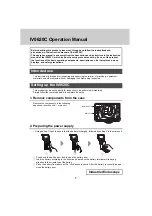
24
User Manual
neuro 200
As is evident from the aforementioned transmitter examples, different transmitters produce signals varying both in
Type
(mV/V/mA) and
Range
. Most PPI instruments, thus, provide programmable Signal Type and Range to facilitate interface with
a variety of transmitters. A few industry standard signal types and ranges offered by the PPI instruments are: 0-50mV, 0-
200mV, 0-5 V, 1-5 V, 0-10V, 0-20 mA, 4-20 mA, etc.
Also, the output signal range (e.g. 1 to 4.5 V) from different transmitters corresponds to different process value range (e.g. 5 to
95 %RH); the instruments thus also provide facility for programming the measured process value range with programmable
Resolution.
The linear transmitters usually specify two signal values (Signal Low and Signal High) and the corresponding Process Values
(Range Low and Range High). In the example Pressure Transmitter above; the Signal Low, Signal High, Range Low & Range
High values specified are: 4 mA, 20 mA, 0 psi & 5 psi, respectively.
In summary, the following 6 parameters are required for interfacing Linear Transmitters:
1. Input Type
: Standard DC Signal Type in which the transmitter signal range fits (e.g. 4-20 mA)
2. Signal Low
: Signal value corresponding to Range Low process value (e.g. 4 mA)
3. Signal High
: Signal value corresponding to Range High process value (e.g. 20 mA)
4. PV Resolution : Resolution (least count) with which to compute process value (e.g. 0.01)
5. Range Low
: Process value corresponding to Signal Low value (e.g. 0.00 psi)
6. Range High
: Process value corresponding to Signal High value (e.g. 5.00 psi)
X
Y
Process V
alue
Transmitter Signal
ΔY
ΔX
Y = mX + C
C
m =
/
ΔY
ΔX
APPENDIX - A
DC LINEAR SIGNAL INTERFACE
This appendix describes the parameters required to interface process transmitters that produce Linear DC Voltage (mV/V) or
Current (mA) signals in proportion to the measured process values. A few examples of such transmitters are;
1. Pressure Transmitter producing
for
4 to 20 mA
0 to 5 psi
2. Relative Humidity Transmitter producing
for
1 to 4.5 V
5 to 95 %RH
3. Temperature Transmitter producing
for
0 to 20 mA
-50 to 250 °C
The instrument (indicator/controller/recorder) that accepts the linear signal from the transmitter computes the measured
process value by solving the mathematical equation for Straight-Line in the form:
Y = mX + C
Where;
X : Signal Value from Transmitter
Y : Process Value Corresponding to Signal Value X
C : Process Value Corresponding to X = 0 (Y-intercept)
m : Change in Process Value per unit Change in Signal Value (Slope)



































